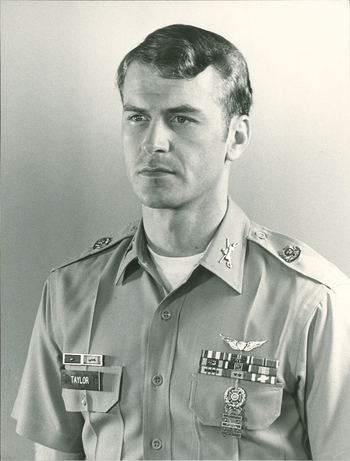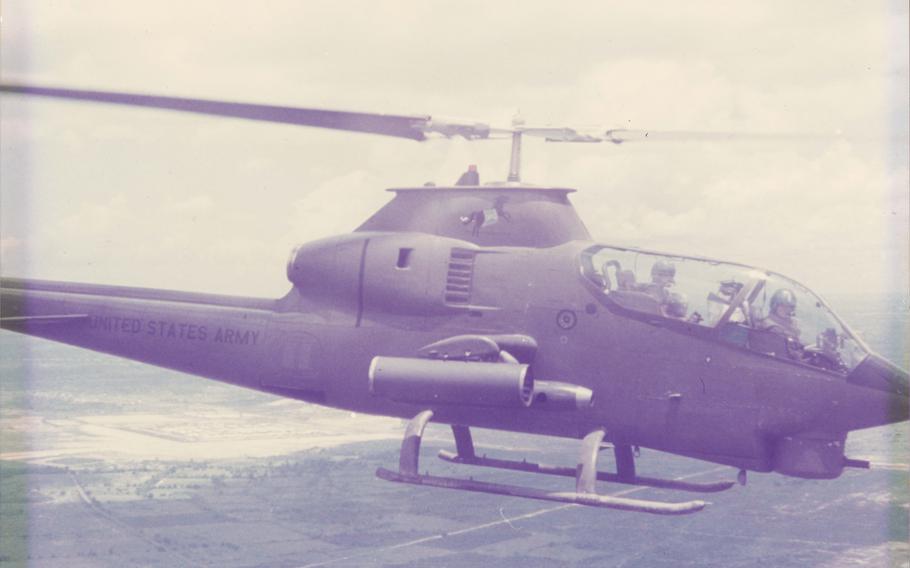.jpg/alternates/LANDSCAPE_910/Larry%20Taylor%20Closeup%20AH-1G%20Cobra%20Helicopter%20-%20Scanned%20from%20Original_Page_1%201.jpg)
Then-1st Lt. Larry Taylor sitting in a UH-1 “Huey” helicopter in an undated photo. After completing flight training, Taylor was assigned to one of the Army’s first Cobra helicopter companies in Vietnam where he served from August 1967 to August 1968. (Larry Taylor and the Coolidge National Medal of Honor Heritage Center)
WASHINGTON — Larry Taylor will become the newest recipient of the military’s highest award for valor in battle when President Joe Biden presents the Vietnam veteran with the Medal of Honor on Tuesday, more than 55 years after his heroic actions in combat.
Taylor, who retired as a captain, was an Army helicopter pilot during the Vietnam War and led a rescue mission in 1968 to save a small group of soldiers trapped in a rice field by enemy troops.
“I was doing my job. I knew that if I did not go down and get them, they would not make it,” said Taylor, now 81 and living in Tennessee.
David Hill, now 75, was a sergeant with the Army Rangers serving as part of a four-man reconnaissance unit on June 18, 1968. He said Monday that if it wasn’t for Taylor’s actions that day, he and the three other men would not have lived.
“Hell, we were dead,” Hill said. “The fortunes of war had turned against us that night.”
Hill’s unit was on a night mission near a village northeast of Saigon when they were surrounded in a rice paddy by a North Vietnamese force. The unit leader could see using a starlight scope that enemy troops were closing in on three sides. But they thought the Vietnamese troops had not surrounded them yet and they could escape back in the direction that they entered the paddy.
They tried to make it back to a tree line, but Hill said he was tapped on his shoulder and told to get down because they had been cut off from getting out.
“We were in a Custer-like situation,” he said.

Larry Taylor, in an undated photo, served in the Army from 1967-1971. He will receive the Medal of Honor next Tuesday for his actions on June 18, 1968, when he rescued a four-man reconnaissance team during the Vietnam War. (Larry Taylor and the Coolidge National Medal of Honor Heritage Center)
Taylor, who was a first lieutenant at the time, got a call on the radio about a four-man unit in trouble. He and another pilot each took a Cobra helicopter and went out looking for the team. Taylor wasn’t certain he would be able to find them because it was such a dark night. But using radio equipment and direction finders, Taylor was able to spot them.
Taylor said the first problem with getting to the trapped soldiers was poor visibility.
“It’s difficult to support you because I can’t see you and I can’t see the bad guys. I’m afraid if I start throwing some rockets out here, I’m going to kill one of you all,” he recalled telling them over the radio.
Taylor instructed the four soldiers to mark their location with flares. Using the flares as a reference point, Taylor and his wingman strafed the North Vietnamese positions with multi-barreled rotary machine guns and rockets.
For nearly 30 minutes, the two American helicopters attacked the enemy troops, expending all their rockets and nearly 16,000 machine-gun rounds.
At that point, Taylor directed the other helicopter pilot to fire his remaining machine gun rounds along the eastern flank of the American patrol and then return to base camp. Taylor fired his own remaining rounds along the unit’s western flank, using his Cobra’s landing lights to draw the enemy’s attention while the U.S. soldiers moved southeast toward a nearby extraction point that Taylor had designated.
“We were finally able to make a breakout because he directed us to the very weakest portion of the enemy envelopment,” Hill said.
There wasn’t time or room in the helicopter for the four soldiers to get inside the two-seat Cobra. When Taylor moved the helicopter into a close position, the soldiers grabbed onto the rocket-pods and skids.
“They beat on the side of the ship twice, which meant haul ass. And we did,” Taylor said.
Hill, who is the last surviving member of the reconnaissance team, and Taylor became friends following the rescue.
Taylor grew up in Chattanooga, Tenn., and graduated from the University of Tennessee at Knoxville in 1966. While there, he enlisted in the Army ROTC and became a second lieutenant. Taylor began ground training at Fort Knox, Ky., before deciding he needed a change.
“If you were on the ground, in the jungle, and there was Charlie behind every other tree, and they shot at you 24 hours a day and mortared you at night. But you had the chance to get in a Cobra … I’d rather be an ass-kicker than have my ass kicked,” Taylor said.
He attended flight training and was assigned to one of the Army’s first Cobra helicopter companies in Vietnam.
Taylor served in Vietnam from August 1967 to August 1968. With the 1st Squadron, 4th Cavalry, 1st Infantry Division, he flew more than 2,000 combat missions in the UH-1 and Cobra helicopters. He concluded his military service in 1971 as a captain in the 2nd Armored Cavalry in what was West Germany at the time.
Taylor was awarded 61 combat decorations, including the Silver Star, 43 Air Medals, a Bronze Star and two Distinguished Flying Crosses. He also received the Republic of Vietnam Gallantry Cross with the Bronze Star.
Hill started a seven-and-a-half-year process serving as Taylor’s nominator to get his Silver Star upgraded to the Medal of Honor. Hill and a couple of his fellow Army Rangers believed the Army and Taylor’s commanders at the time had failed in not getting him the highest military honor. They felt it was an injustice.
“We looked, ‘Yeah, we did this and you do that. But look at what Larry Taylor did,’ ” Hill said. “It’s not in the same ballpark … with what the rest of us did. Larry not only did his job. He went way, way above the call of duty.”

Then-1st Lt. Larry Taylor flying a Cobra in the mid-to-late 1960s. He flew more than 2,000 combat missions during his time as an Army aviator during the Vietnam War. (Larry Taylor and the Coolidge National Medal of Honor Heritage Center)
Mike Holden, a family friend of Taylor’s, served as an infantry platoon sergeant in Vietnam for two years. He said as part of the rules for receiving the Medal of Honor, a person’s commanding officer must recommend the soldier for the award. In Taylor’s case, his commander Gen. Keith Ware died in battle.
“So that just put it in the closet, in the background. It was forgotten,” Holden said.
But Hill worked with multiple people and groups. He started by writing a letter to then-Sen. Bob Corker, R-Tenn., telling him about a constituent from Signal Mountain who deserved the Medal of Honor.
Hill, Holden and others working on the submission struck out twice with the Army. Following the second attempt, the Army said it would not override the original decision unless new or substantiating evidence came to light, Hill said.
Retired four-star Army Gen. B.B. Bell had started working with the team about two years ago and encouraged them not to give up. Bell retired in 2008 but serves on the board of the Coolidge National Medal of Honor Heritage Center in Chattanooga. Hill submitted an appeal to the Army Board for the Correction of Military Records, or ABCMR.
The board rejected that submission. But Hill and the group discovered commanders never interviewed other soldiers who witnessed the rescue that night in 1968. That information was included in a third submission, and it worked.
“After all these years, two weeks later the ABCMR sent a letter back to me saying, ‘You have prevailed,’ ” Hill said. “As Larry would say, ‘It worked out finally.’”
Taylor said he got a call last month from Biden informing him that he would be the newest soldier to receive the medal. More than 41 million men and women have served in the U.S. military, and slightly more than 3,500 medals have been awarded.
Taylor said he is proud to receive the Medal of Honor — the “ultimate award.” But he also said he is most proud that he followed the military motto that he had requested for his Medal of Honor challenge coins that recipients design — “leave no man behind.”